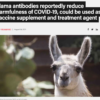Comparison of immune responses in calves fed heat-treated or unheated colostrum
Colostrum treatments and calves assigned to each are described in Table 2, and values from RID and ELISA for colostrum IgG are given. The ELISA has been shown to underestimate IgG concentration relative to RID, and direct comparison of values between
methods is discouraged (Gelsinger et al., 2015b). The majority of this
discussion will focus on the results from RID, because it is the most commonly
used method in published research and the basis of industry recommendations for
colostrum quality and passive transfer of IgG.
Feeding colostrum heated to 60°C for 60 min to newborn dairy calves reduced circulating IL1β through 14 d of age. Despite a lower IL1β concentration, we observed no differences in body temperature, IFNγ, or IgG; however, calves fed UH colostrum tended to regain ADG more rapidly following ovalbumin injection. These results indicate that HT colostrum does not inhibit the neonatal immune response but may affect recovery from exogenous antigen challenge. Further research is needed to continue characterizing the role of colostrum factors in neonatal development, including comparisons of immune cell function and activity, in addition to cytokines and growth factors that were not included in the present study.
As published by the Journal of Dairy Science, May 2017 by S. L. Gelsinger and A. J. Heinrichs1 Department of Animal Science, The Pennsylvania State University, University Park 16802
 Veterinary Business
Veterinary Business 




